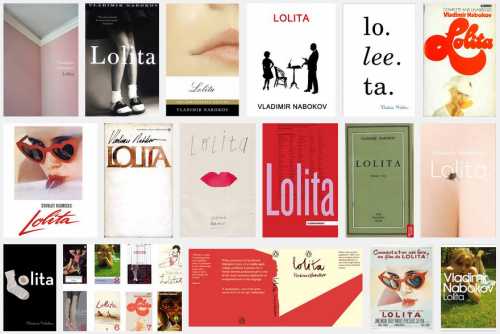You are here
Google Images and Book Covers - Tracking Cultural Change
Primary tabs

Screen shot of Lolita book covers retrieved with Google image search
Images on book covers, blurbs or reviews on dust jackets, and publishers’ summaries all provide constructed argumentation about the text within that is designed to provoke an emotional and analytic response. This lesson plan is designed to get students thinking about the ways in which cover images provide valuable evidence in the way in which a text (in this case, Vladimir Nabokov’s Lolita) is marketed and interpreted over time.
I created this lesson for a networked classroom where each student could have internet access, though a classroom without could request that students print out their images the night before, or profitably use a projector as the groups present.
Students are often presented with paratextual apparati that contributes to determining their response to a work of literature. Images on book covers, blurbs or reviews on dust jackets, and publishers’ summaries all provide constructed argumentation about the text within that is designed to provoke an emotional and analytic response. This lesson plan is designed to get students thinking about the ways in which cover images provide valuable evidence in the way in which a text (in this case, Vladimir Nabokov’s Lolita) is marketed and interpreted over time. I found that this in turn could contribute to a discussion of a text as a historical document.
Before this class I had given a brief lecture on the history of the composition and publication of Lolita, and we looked at and analyzed the original French cover together, asking questions that were quite similar to the ones in the student prompt.
I had my students log into their computers and head to Google Images. I broke my students up into two- or three-person teams as I have 22 students in this class, but this is of course optional. (NB: Depending on the text, you may wish to enable the “safe search” function on your computers—searching Lolita brought up some occasionally questionable material.)
I handed out prompts to each group (see below in student instructions).
After 20-25 minutes, we came back together and we took a tour through the classroom, where each group gave a brief presentation based on their prompt for the rest of the class.
I did this in one 45-minute class, but the assignment could easily be expanded or transformed into a take-home exercise as needed. In the future I think I will try to make this a two-day exercise. I’d like to have the students upload their images to a class wiki, so that we could easily put them into chronological order, which would allow us to clearly and easily see how the images change (or remain static) over time.
Your goal in this exercise is to think about how a cover image for the novel Lolita constructs a reader's response to the novel. What kinds of things does this image make us think? What does it say about the novel at that historical moment? To do so, you will use Google Images to find a striking cover image for the novel and analyze the image.
- Once you’ve logged into your computers, head to Google Images
- When you’ve arrived at Google Images you and your partner should search for some cover images used on the novel Lolita. Try some different searches—adding different key words (cover vs book) or countries (America vs Australia) will often provide you with different content.
- Discover when and where your image was created—is it a Turkish edition from 1959? A Russian edition from the 1990’s? An American edition from the 2000’s? What type of image is it—a photograph? A drawing? A painting? Is it an identifiable piece of art (a famous painting or photograph) or does it look like it was commissioned for that edition?
- With your partner, think about and brainstorm some answers to the following questions: What are the first words that come into your mind when you see this image? What does it make you think of? If you hadn’t read any of the novel, what would this image make you think the book was about? Now that you’ve read (some of ) the novel, what kind of relationship(s) does this image have to the text? Who seems to be portrayed? From whose viewpoint are we looking? Does this image spark any ideas about the cultural construction of the book? What kinds of people would make this book, and what kinds of people would read it? These questions are only a starting place. Please feel free to explore and think about more issues raised by your image.
Be prepared to enlighten the rest of the class about the image you’ve chosen (when and where it’s from, and a brief summary of your thinking about part 4) for about 3-5 minutes.
I did not formally evaluate this assignment except as part of daily class participation
This was an easy and even fun way to get a conversation started about how paratexts can affect the ways that we read, and also helped us to talk about how different cultural and historical moments look at texts differently. Students who are sometimes reluctant to traditionally close-read in class can often surprise themselves with a sophisticated reading of a visual text, and keeping the exercise group-oriented and low stakes allows them to demonstrate their skills with little pressure.
-

- Log in to post comments

